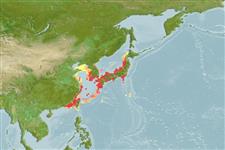Environment: milieu / climate zone / depth range / distribution range
Ecología
marino demersal; no migratorio; rango de profundidad 0 - 30 m (Ref. 6205). Subtropical; 45°N - 21°N, 116°E - 149°E (Ref. 6205)
Northwest Pacific: Japan, Korea, China, and Taiwan. Possibly to the Philippines. Commonly misidentified as Sillago sihama.
Tamaño / Peso / Age
Maturity: Lm ? range ? - ? cm
Max length : 30.0 cm TL macho / no sexado; (Ref. ); common length : 22.0 cm SL macho / no sexado; (Ref. 6205)
Espinas dorsales (total): 12; Radios blandos dorsales (total): 21-23; Espinas anales 2; Radios blandos anales: 22 - 24; Vértebra: 35. Swim bladder with anterior projecting extensions and a single posterior extension. Body is greenish gray above, the dorsal part of the head being the darker, and whitish below. The fins are mostly hyaline; the membrane between the first to the third dorsal fin spines with minute dark brown dots; the margins of the dorsal fin with a few dark brown spots. The caudal fin with dark margins.
Occur in bays on shallow sandy flats. Maximum size is over 30 cm (Mark Donachy, pers. comm., 2001). Oviparous (Ref. 205). Greatly esteemed for its delicate flavor (Ref. 6205).
Life cycle and mating behavior
Madurez | Reproducción | Puesta | Huevos | Fecundidad | Larva
McKay, R.J., 1992. FAO Species Catalogue. Vol. 14. Sillaginid fishes of the world (family Sillaginidae). An annotated and illustrated catalogue of the sillago, smelt or Indo-Pacific whiting species known to date. Rome: FAO. FAO Fish. Synop. 125(14):87p. (Ref. 6205)
IUCN Red List Status (Ref. 130435)
Threat to humans
Harmless
Human uses
Pesquerías: comercial; Acuicultura: posible uso futuro
Más información
Nombres comunesSinónimosMetabolismoDespredadoresEcotoxicologíaReproducciónMadurezPuestaAgregación para la puestaFecundidadHuevosEgg development
ReferenciasAcuiculturaPerfil de acuiculturaRazasGenéticaElectrophoresesheritabilidadEnfermedadesProcesamientoNutrientsMass conversion
ColaboradoresImágenesStamps, Coins Misc.SonidosCiguateraVelocidadTipo de nataciónSuperficie branquialOtolitosCerebrosVisión
Herramientas
Special reports
Download XML
Fuentes de Internet
Estimates based on models
Preferred temperature (Ref.
123201): 16.1 - 25.4, mean 21.3 °C (based on 238 cells).
Phylogenetic diversity index (Ref.
82804): PD
50 = 0.5000 [Uniqueness, from 0.5 = low to 2.0 = high].
Bayesian length-weight: a=0.00631 (0.00395 - 0.01009), b=3.05 (2.91 - 3.19), in cm total length, based on LWR estimates for this species & Genus-body shape (Ref.
93245).
Nivel trófico (Ref.
69278): 3.5 ±0.52 se; based on food items.
Resiliencia (Ref.
120179): Alto, población duplicada en un tiempo mínimo inferior a 15 meses (Preliminary K or Fecundity.).
Fishing Vulnerability (Ref.
59153): Low vulnerability (20 of 100).
